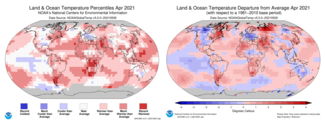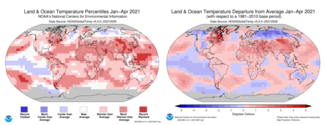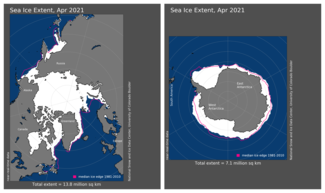Ninth-warmest April on record; below-average Arctic sea ice extent

The global temperature for April 2021 was the ninth highest for the month of April in the 142-year NOAA record, which dates back to 1880. The year-to-date (January-April) global surface temperature was the eighth highest on record. According to NCEI’s Global Annual Temperature Rankings Outlook, it is very likely that the year 2021 will rank among the 10 warmest years on record.
This monthly summary, developed by scientists at NOAA’s National Centers for Environmental Information, is part of the suite of climate services NOAA provides to government, business, academia and the public to support informed decision-making.
Global Temperature
The April 2021 global surface temperature was 1.42°F (0.79°C) above the 20th-century average of 56.7°F (13.7°C). This was the coolest April since 2013 and the ninth warmest April in the 142-year record. April 2021 marked the 45th consecutive April and the 436th consecutive month with temperatures, at least nominally, above the 20th-century average.
Temperatures were much above average across eastern Canada, southern South America, parts of northern and southern Africa and western Asia. Parts of the northern and southern Pacific Ocean and northern Atlantic Ocean were also above average.
In contrast, parts of Alaska, the western half of Canada, the central contiguous U.S., Europe, central Asia, Australia, eastern Antarctica and the eastern tropical Pacific Ocean were cooler than average.
Regionally, South America and Africa had an April temperature that ranked among the seven highest on record. Meanwhile, Europe and Asia had their coolest April since 2003 and 2015, respectively.
Sea Ice and Snow Cover
The Arctic sea ice extent in April averaged 5.34 million square miles, which was 328,000 square miles (5.8 percent) below the 1981-2010 average and the sixth-smallest April extent in the 43-year record, according to an analysis by the National Snow and Ice Data Center (NSIDC) using data from NOAA and NASA. Sea ice extent was below average in the Barents, Bering and Labrador Seas and near average elsewhere.
The Antarctic sea ice extent during April 2021 was 88,800 square miles (3.4 percent) above average and the largest April sea ice extent since 2016. Sea ice extent was below-average in the northwestern Weddell Sea and northern Ross Sea, where April temperatures were above average.
According to data from NOAA and analyzed by the Rutgers Global Snow Lab, the Northern Hemisphere snow cover extent during April was 30,000 square miles below average and was the 11th-smallest April extent on record. The North American snow cover extent was the 10th smallest on record, while Eurasia had its 16th-smallest April snow cover extent on record.
For a more complete summary of climate conditions and events, see our April 2021 Global Climate Report.








